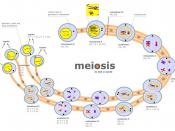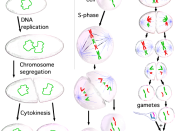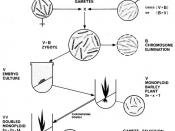DNA & Molecular Biology
DNA: double helix molecule that is blueprint for almost every cell or organism on the planet. Deoxyribonucleic acid's structure was discovered by Watson & Crick in 1953.
Chromosome: coiled length of DNA seen during cell division but not during interphase. Chromosome attaches to spindle fibres at the centromere in prophase.
Allele: Specific version of gene or function sequence of DNA. Version may be 'normal' (which is most common in gene pool), or any one of many visibly (measurably) different mutant versions
Homologous Chromosomes: 1 of 2 almost identical copies of DNA which normally contains at least a few genes that are heterozygous. Note: Homologous chromosomes pair when in diploid condition, but do not pair when in the haploid (gamete) state.
Ploidy Number: number of complete sets of chromosomes in a cell which contains all necessary genes for normal development, growth, and function. Note: Diploid (2n) has sets of chromosomes in almost every cell of the body except the gametes which are haploid (monoploid).
Most organisms are diploid, but some species are polyploidy (Chinook salmon are decaploid).
Mitosis: Sexual cell division in almost every body cell type, resulting in genetically identical diploid cells (a clone).
Meiosis: Sexual cell division in the gonads (ovaries or testes) resulting in haploid cells that each are samples of the parental genotype.
Segregation of Genes: basis for meiosis which occurs in anaphase 1 when chromosomes are pulled apart without centromeres splitting. This process virtually guarantees gametes will be of many different genetic make-ups.
Phenotype: Physical appearance of a cell or organism as controlled by the genetic make-up (genotype). Most common appearance is usually termed 'wild type' (normal), while less common appearances are seen as mutant.
Genotype: Description of paired alleles for any gene. Can be heterozygous, homozygous or hemizygous.
Dominance: Condition...


